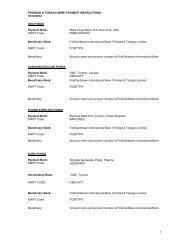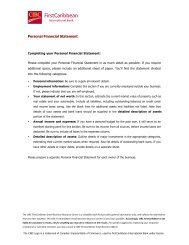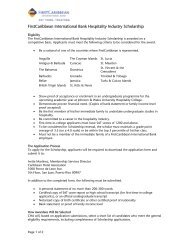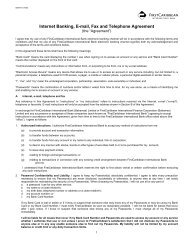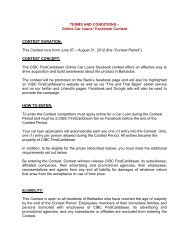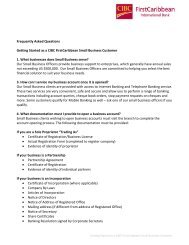FirstCaribbean International Bank (Bahamas) Limited
FirstCaribbean International Bank (Bahamas) Limited
FirstCaribbean International Bank (Bahamas) Limited
- No tags were found...
You also want an ePaper? Increase the reach of your titles
YUMPU automatically turns print PDFs into web optimized ePapers that Google loves.
Notes to Consolidated Financial StatementsFor the year ended October 31, 2009(Expressed in thousands of Bahamian dollars)26. Financial Risk Management (Continued)E. Market risk (continued)Foreign exchange risk (continued)Concentrations of assets, liabilities and credit commitments (continued)BAH US Other Total$ $ $ $October 31, 2008Total assets 1,911,125 2,011,303 215,562 4,137,990Total liabilities 1,733,361 1,491,500 267,317 3,492,178Net on balance sheetposition 177,764 519,803 (51,755) 645,812Credit commitments (Note 23) 110,202 190,782 1,636 302,620Derivatives held for asset and liability management (ALM) purposesWhere derivatives are held as hedges against either sizeable loans from core businesses or to reduce interest riskexposure to USD denominated local bond issues and the transactions meet the accounting criteria then the <strong>Bank</strong>applies hedge accounting. Derivative hedges that do not qualify for hedge accounting ant are considered to beeconomic hedges and are recorded at fair value on the balance sheet with changes in the fair value recognized throughprofit or loss. It should be noted that these are only interest rate risk hedges and other risks such as credit spread onthe underlying still exist and are measured separately.F. Cash flow and fair value interest rate riskCash flow interest rate risk is the risk that the future cash flows of a financial instrument will fluctuate because ofchanges in market interest rates. Fair value interest rate risk is the risk that the value of a financial instrument willfluctuate because of changes in market interest rates. The <strong>Bank</strong> takes on exposure to the effects of fluctuations in theprevailing levels of market interest rates on both its fair value and cash flow risks. Interest margins may increase as aresult of such changes but may reduce or create losses in the event that unexpected movements arise. Limits are seton the level of mismatch of interest rate repricing that may be undertaken, which are monitored on an ongoing basis.Expected repricing and maturity dates do not differ significantly from the contract dates, except for the maturity ofdeposits up to 1 month, which represent balances on current accounts considered by the <strong>Bank</strong> as a relatively stablecore source of funding of its operations.G. Liquidity riskLiquidity risk arises from the <strong>Bank</strong>’s general funding activities in the course of managing assets and liabilities. It is therisk of having insufficient cash resources to meet current financial obligations without raising funds at unfavourablerates or selling assets on a forced basis.The <strong>Bank</strong>’s liquidity management strategies seek to maintain sufficient liquid financial resources to continually fund theconsolidated balance sheet under both normal and stressed market environments.Process and control:Actual and anticipated inflows and outflows of funds generated from on and off-balance sheet exposures are managedon a daily basis within specific short-term asset/liability mismatch limits by operational entity.Potential cash flows under various stress scenarios are modelled using consolidated balance sheet positions. On aconsolidated basis, prescribed liquidity levels under a selected benchmark stress scenario are maintained for a minimumtime horizon.63



